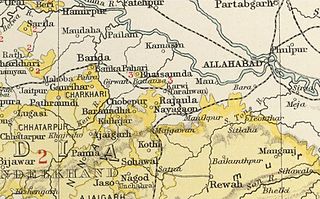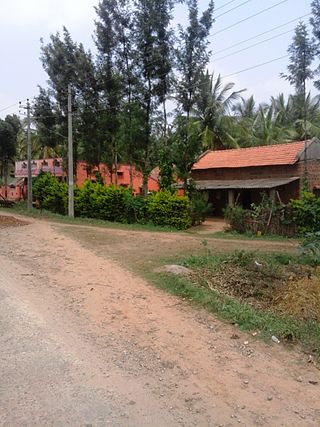Bhat is a Brahmin and Muslim surname in the Indian subcontinent. Bhat and Bhatt are shortened renditions of Brahmabhatta or Bhatta.

Rādhā Soāmī Mat or Sant Mat is a spiritual tradition or faith founded by Shiv Dayal Singh in January 1861 on Basant Panchami Day in Agra, India.

Belagavi district, formerly also known as Belgaum district, is a district in the state of Karnataka, India. The district is known as the sugar bowl of Karnataka with 150,000 hectares being used for commercial production. It has overtaken Mandya district in sugarcane production over the last decade. The city of Belgaum (Belagavi) is the district headquarters in Belagavi district. It houses the Second legislative building, where the Karnataka Legislature holds session once a year. The district is famous for its native sweet, Kunda. According to the 2011 Census of India, it has a population of 4,779,661, of which 24.03% live in urban areas, making it the second most populous district in Karnataka, after Bangalore Urban. The district has an area of 13,415 km2 (5,180 sq mi), making it the largest district in terms of size in Karnataka It is bounded by Kolhapur District and Sangli district of Maharashtra state on the west and north, on the northeast by Bijapur district, on the east by Bagalkot district, on the southeast by Gadag district, on the south by Dharwad and Uttara Kannada districts, and on the southwest by the state of Goa.
Das is a common last name in South Asia, among adherents of Hinduism and Sikhism, as well as those who converted to Islam or Christianity. It is a derived from the Sanskrit word Dasa meaning servant, devotee, or votary. "Das" may be inferred to be one who has surrendered to God. The surname is often used by those in the Vaishnav community.

A shaligram, or shaligrama shila, is a fossilized stone or ammonite collected from the riverbed or banks of the Kali Gandaki, a tributary of the Gandaki River in Nepal. It is also considered a form of Vishnu within Hinduism. The Kali Gandaki river flows through sacred places such as Muktinath and Damodar Kunda, enhancing the spiritual significance of these shaligrams.

Chunchanakatte Falls is a waterfall on the Kaveri River, near the village of Chunchanakatte in saligrama taluk of Mysore district, Karnataka, India. Water cascades from a height of about 20 meters. It is in the Western Ghats. Here the river falls in two small cascades before joining again to flow as one.
Dhar is an Indian surname. It is commonly found among the Hindu Bengali Kayastha and Baniks including Subarnabanik community in Bengal region. Dhar or Dar is also used by some Kashmiri and Punjabi-Kashmiri clans and communities native to the Kashmir Valley and Punjab, and common today among Kashmiri Hindus and Kashmiri Muslims.
Krishnarajanagara is a town in Mysore district in the Indian state of Karnataka. It is also the administrative center of Krishnarajanagara Taluk.

Vidyalankara Saligrama Krishna Ramachandra Rao was an Indian author, Sanskrit scholar and professor of psychology.
Saligrama is a town on NH 66 in Brahmavara taluk of Udupi district in the Indian state of Karnataka. It is located between Kundapura and Brahmavar. It is 24 km north of Udupi and 81 km from Mangalore.
A dvaravati shila is a type of coral stone (shaligrama) obtained from the Gomti river in Dwarka in Gujarat, India. In ancient Sanskrit literature, Dvaraka was called Dvaravati and was listed as one of the seven prehistoric cities in the country.

Salig Ram, successor of Shiv Dayal Singh second Sant Satguru of the Radhasoami Satsang popularly known by the honorific "Huzur Maharaj" and by the government-conferred title "Rai Bahadur," was born in Peepal Mandi, Agra, on 14 March 1829. He served as chief inspector of post offices in British India, and, in 1881, was Postmaster-General of the North-Western Provinces, based in Allahabad. He was the first Indian to hold the position.

Baba Devi Sahab (1841–1919) was one of the leaders of the Sant Mat religious movement, popularizing it throughout North India and Pakistan.

Pahra was a jagir in India during the British Raj. It was under the Bundelkhand Agency of the Central India Agency until 1896 when it was transferred to the Baghelkhand Agency. It was later transferred back to the Bundelkhand Agency.
Markanda is a former name for the city of Samarkand in Uzbekistan.

Keralapura is a village in Arkalgud taluk in the Hassan district of Karnataka state, India.
Saligrama Ramegowda Mahesh is an Indian politician who served as Minister of Tourism and Sericulture from 6 June 2018 to 8 July 2019 and he is currently Member of Karnataka Legislative Assembly from Krishnarajanagara Assembly constituency since 2008.
Jaiswal or Jayswal or Jayaswal is a surname used by many Hindu communities. Jaiswals are mainly traders and deal in various commodities. In the past, some of them excelled in the art of liquor making.

Dr. Salig Ram was a medical doctor, freedom fighter, and politician from Himachal Pradesh, India. He belonged to the Indian National Congress. Over 1966–72, he served as a Member of Parliament from Himachal Pradesh in the Rajya Sabha. Over 1972–77, he served as a Minister with various portfolios in the Government of Himachal Pradesh, principally under the Chief Ministership of Y.S. Parmar and later for a brief period under Thakur Ram Lal. He was known as a dissident of Y.S. Parmar.








